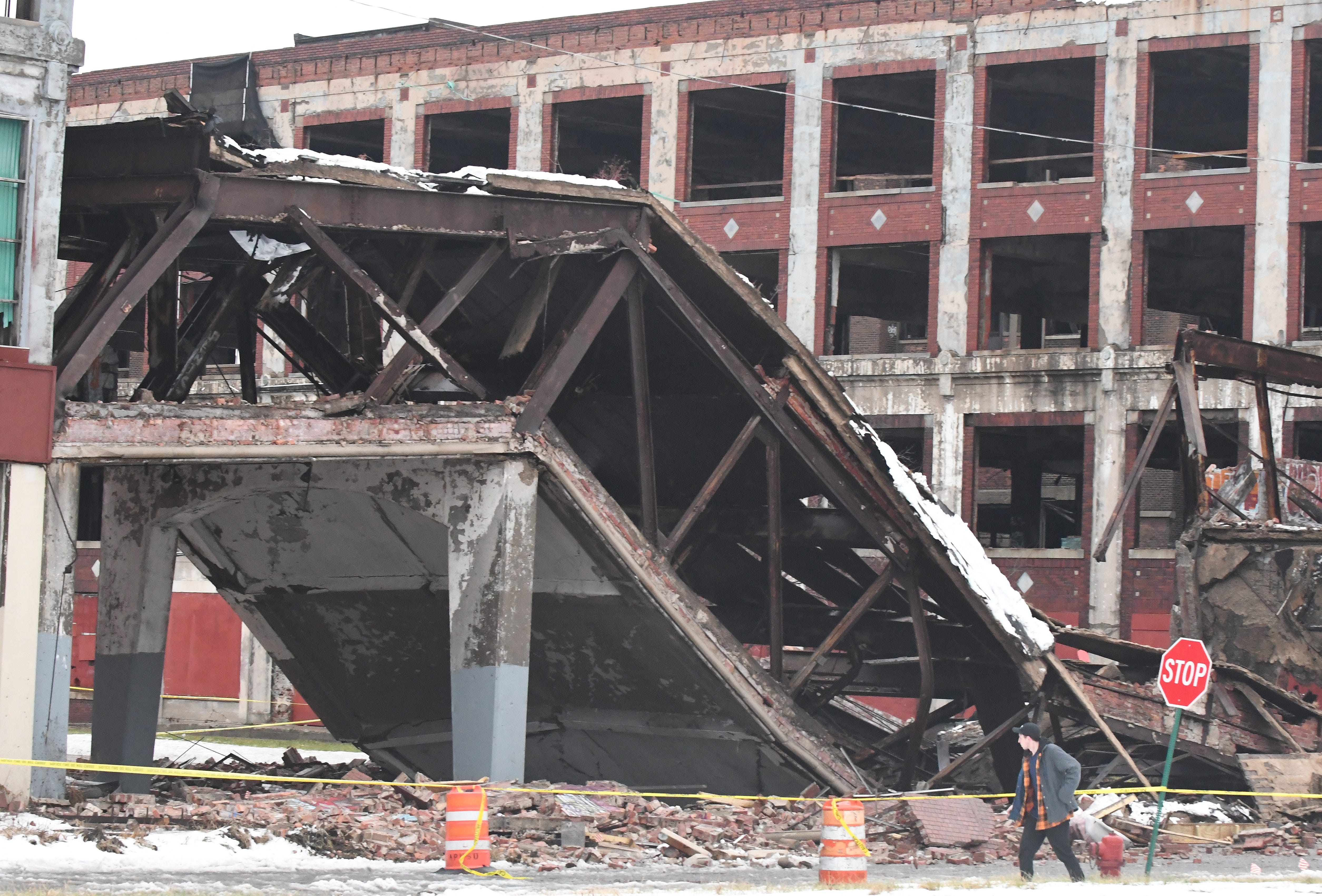Weather fluctuations likely to blame in collapse of bridge at old Packard Plant

Detroit — The iconic pedestrian bridge at the long-shuttered Packard Plant, which was once part of the plant's assembly line, likely collapsed Wednesday due in part to age and extreme weather fluctuations, a spokesman for the property owner said.
Wednesday evening, the Detroit Building Authority contracted with Blue Star Demolition to remove the bridge, and workers were assessing the site.
"We expect that active work will begin in the morning," the city said. "There is no timeline yet established for the completion of work and the reopening of the road."
The bridge fell onto East Grand Boulevard at about 3 p.m. Wednesday, said Joe Kopietz, a spokesman for Arte Express, whose owner, Peruvian developer Fernando Palazuelo, bought the plant in 2013 at a Wayne County tax auction.
"Our contractors on site noted some bricks falling from that bridge earlier today," Kopietz said. "We were informed at about 1 this afternoon, and I directed the contractor to make efforts to block off traffic.
"I called (Detroit's Building and Safety and Housing and Revitalization departments), and was waiting for a return phone call. At about 2, it came to light that some people were driving around the barrier we'd put up. So I called Detroit police to see if they could assist in blocking the traffic.
"Then, at about 3 this afternoon, the collapse occurred. The best we can determine is that it was a preexisting structural issue, due to temperature fluctuations that caused the collapse."
Kopietz said the city owns the building at 1539 E. Grand Blvd. that connects to the bridge, and that the bridge is jointly owned by the city and Arte Express.
"We have calls into the city of Detroit to discuss how to move forward, given the joint ownership of the bridge," Kopietz said. "Mr. Palazuelo has reiterated his desire to convince the city to transfer control of that building to us, at least under a development agreement, to stabilize and secure it."
Shortly before 6 p.m., the city released a statement that read: "Today, a portion of the Packard Plant pedestrian bridge collapsed over East Grand Boulevard. No injuries have been reported and the affected portion of the road has been shut down by the Detroit Police Department."
Detroit police Sgt. Nicole Kirkwood said units from the 7th Precinct were sent to the plant to help divert traffic. She said she was unsure if police got to the location before the collapse, adding that units were on the scene later Wednesday.
Police and security staff kept passersby away from the crumpled metal and brick debris on the rain-slicked roadway between two empty buildings.
Marvin King of Northville Township, who has belonged to the Packard Club for decades and owns a storage building nearby, rushed to the scene after hearing about the bridge collapse.
More: Hopes rise for Packard site 20 years after police standoff
Seeing the plant’s span draped across the pavement “is like losing an old friend,” King said, who showed a reporter pictures in his wallet of the Packards he had driven over the years. “Nothing lasts forever. I guess ... I doubt we’ll ever see that bridge recreated.”
The Packard plant is a network of several buildings on 42 acres, totaling 3.5 million square feet. The plant, which was built in 1903, stopped producing cars in 1956.
The bridge once was part of the plant's assembly line. Auto bodies were assembled in the building on the south side of Grand Boulevard, and they traveled across the street via the assembly line built into the bridge to the northern building, where each chassis was put together.
The bridge became the subject of media attention in 2013, when letters spelling the Nazi slogan that was put on the fences of concentration camps, "Arbeit macht frei" ("Work sets you free"), were placed in the windows. The message was promptly removed.
The collapsed bridge was erected in 1939, and there were several other bridges connecting the various buildings at the plant over the years.
Palazuelo plans to turn the plant into a mixed-use development. He has spent more than $5 million to clear more than 17,000 yards of debris since purchasing the plant for $405,000 in back taxes.
ghunter@detroitnews.com
(313) 222-2134
Twitter: @GeorgeHunter_DN
Staff Writer Mark Hicks contributed to this report.